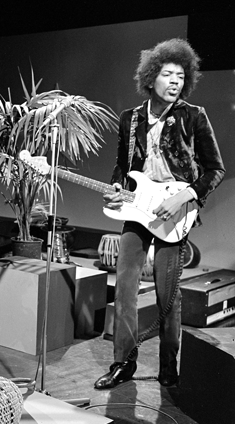1.Prologue
In our “The Legacy of Psychedelic Music" series, I’ve written about the hippie movement and psychedelic music of San Francisco and Los Angeles, and the mutual influence between American and British acts during the so-called “British Invasion".
In this column I’ll be writing about hippie movement and psychedelic rock icon Jimi Hendrix, as well as his influence on the three British guitarists that would be at the forefront of psychedelic blues and the development of hard rock.
Why did British working class musicians become enamored with American rock? And why did they see it as imperative to break the American market? Also, why did Jimi Hendrix—a black musician—embrace hippie culture—a white phenomenon—and why was he able to attain stardom in Britain?
These are some of the questions I will address in this column as I go over how Britain developed its own style of rock music in the 60s. Along the way, I also hope to consider some fundamental differences between British and American society.
2.The Yardbirds and the Guitar Rock Triumvirate
Eric Clapton, Jeff Beck, and Jimmy Page, who are known in Japan as 3大ロック・ギタリスト (the three rock guitar greats), all got their start in the Yardbirds. The Yardbirds were a British blues band that brought together working-class musicians from the London rhythm and blues scene—the same scene that gave birth to The Rolling Stones—and while they did not attain the same level of fame as the Beatles or the Stones, they are considered a seminal group of the era for their contributions to the development of psychedelic rock and blues rock. Clapton, Beck, and Page, three lads who had all (mostly) taught themselves to play guitar, would each build on a foundation of African-American blues to widen the possibilities of the guitar.
Clapton’s tenure with the Yardbirds mostly involved covers of American blues and R&B songs, and he would leave the band when he felt that it was starting to break away from his blues purist sensibilities. Jeff Beck would replace him, and push the band toward a more psychedelic sound. The Beatles are often cited for incorporating the sitar into its music, but it turns out the Yardbirds were the first, with Beck’s first single with the band, 1965’s “Heart Full of Soul". The band initially hired an Indian sitar player to play on the track, but when they felt that the sound was too soft, Beck played the part himself, using a sitar-like guitar effect.
The band’s February 1966 single “Shape of Things" is considered by some to be the first psychedelic rock song.
Later, with the addition of Jimmy Page, the band would set the standard for twin lead guitar music. On their song “Happenings Ten Years Ago", you can hear not only the evolution of their psychedelic rock sound but also the beginnings of the hard rock sound that Page would later explore with Led Zeppelin.
Beck would leave the group during their 1966 American tour, and the Yardbirds would disband not too long afterwards. It was right around this time that Jimi Hendrix arrived on the scene like a force of nature.
3.Psychedelic Rock Icon, Jimi Hendrix
With his electric afro hair, Eastern-inspired “kimonos", bellbottoms, and bandana, Jimi Hendrix is perhaps the most iconic figure of the hippie movement and psychedelic rock.
Hendrix—or as he’s known in Japan, Jimi-hen—actually broke through in the UK before he broke through in his home country. In 1966, Keith Richards’ girlfriend saw Hendrix playing at a live show in New York and was “mesmerised". At the time, Hendrix was barely making a living playing on the R&B circuit. Richards' girlfriend introduced Hendrix to a British producer—Chas Chandler, the original bassist of The Animals—who brought him to London to sign him to a management and production contract. Soon after, he was joined by bassist Noel Redding and drummer Mitch Mitchell (two white English musicians) to form The Jimi Hendrix Experience.
Within six months, the band had scored three top-10 singles in the U.K. One of those singles was “Purple Haze", an iconic psychedelic rock song that became arguably his most famous work. Hendrix himself said the song was about a dream he had, but many have put forth either that the purple haze refers to marijuana (some cannabis strains are purple) or LSD (acid trips can be colorful affairs).
Hendrix also stunned his British guitarist peers with his live performances. Shortly after he’d arrived in London, he went to a Cream show with his producer, and he asked Eric Clapton if he could jump up on stage to jam. It’s said that when Hendrix started shredding through the blues tune “Killing Floor”, Clapton, unable to keep up, stormed off stage. Clapton recalled the moment in an interview, saying "My life was never the same again."
One of the Jimi Hendrix Experiences’ first live performances was attended by Clapton, Jeff Beck, John Lennon, Paul McCartney, Brian Jones, and Mick Jagger, among others. Beck later revealed that he had thought to himself, “Well, I used to be a guitarist.”
After establishing his dominance in the U.K. scene, he returned to the U.S., where he gatecrashed the psychedelic rock scene with his legendary performance at the 1967 Monterey Pop Festival. Then in 1968, he released his third—and what would be his final—studio album, Electric Ladyland. The album would be his first No. 1 hit in the U.S. By the time he was headlining Woodstock in 1969, he had become the highest-paid performer in the world.
Electric Ladyland
The Jimi Hendrix Experience’s third and final studio album is considered a classic of psychedelic rock. Standout tracks include Voodoo Child (Slight Return", and the cover of Bob Dylan’s “All Along the Watchtower". Rolling Stone magazine ranked it 55th on its list of the “500 Greatest Albums of All Time."
Hendrix’s performance of the Star-Spangled Banner at Woodstock was both his way of protesting the Vietnam War, where many black soldiers were being killed, as well as his way of announcing in no uncertain terms that America was also his land.
Two weeks after Woodstock, Hendrix held a free concert for the African-American community in Harlem, New York. However, as soon as he took to the stage, someone threw a bottle that shattered against a speaker before he could even start playing. Eggs followed, and the audience began to disperse. In their eyes, Hendrix was a traitor—someone who had left the U.S. and the civil rights movement behind to play the white psychedelic music of their oppressors. At the time, black radio stations refused to play Hendrix’s music.
It may seem strange that a black man like Hendrix would be drawn to the hippie movement, which was largely comprised of young middle class whites. Perhaps, having experienced poverty and racism firsthand from a young age, the ideals of “love and peace" and “the unity of all living beings" resonated with him. Perhaps in his eyes, music was universal—there was no separation between "white music" and "black music". And in the U.K., he may have been struck by the fact that while there was a rigid class society, the racial discrimination was not as bad as it was in the U.S. His undying hope and idealism may have been why he aligned himself with the hippie movement.
There is another reason that British audiences had welcomed Hendrix: the British fascination with the exotic, or to put it another way, orientalism. That tradition began with the British Empire between the late 16th and early 18th centuries, and continues today in varying degrees with the British obsession with tea, curry, and cricket. It’s also why the Yardbirds and the Beatles incorporated the sitar into their music. A black man, dressed in oriental-looking designs, playing the white music of psychedelic rock, would have been in their eyes the epitome of exoticism. Add to that the way Hendrix asserted himself on stage, playing his guitar with his teeth or handling it like the male anatomy. Imagine how it must of felt for young working-class Britons who had grown up in a conservative society.
4.Rock’s First Supergroup: Cream
After Eric Clapton left the Yardbirds, he would join John Mayall & the Bluesbreakers for one album before he would be inspired to form Cream after seeing legendary blues guitarist Buddy Guy perform in a trio.
Cream is regarded as the world’s first rock supergroup, and its distinctive, heavily distorted guitar sound would lay the groundwork for British hard rock musicians to come.
Compared to the blues-leaning vibes of their first album, Fresh Cream, their second, Disraeli Gears, took their sound in a more psychedelic direction. (This is also reflected in the fact that the album’s Japanese title is Colorful Cream.)
Disraeli Gears
Released in 1967, this psychedelic rock album was Cream’s breakthrough album in the U.S., and the band would play its first headlining U.S. dates in August. Rolling Stone magazine ranked it 114th on its list of the 500 Greatest Albums of All Time.
The album’s standout track is the hard rock song “Sunshine of Your Love", which was actually written after the members of Cream had attended a Jimi Hendrix Experience concert in London. Bassist Jack Bruce went home after the concert and wrote the distinctive bass riff. Later, Hendrix himself would cover the song in concert.









